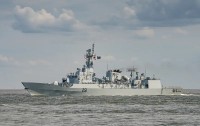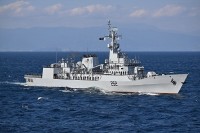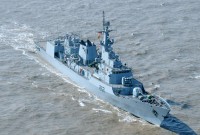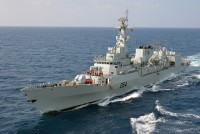Zulfiquar-class frigate (F-22P)
Basic information
Ship measurements
Machine
- 4 * Pielstick 16PA6STC at 5.1 MW (6,800 hp)
- 4 * MTU diesels generator set 8V396TE54 at 680 kW (910 hp)
Personnel
Combat assets
- SUR 17 / Type 517 long range radar air surveillance radar
- SR-60 / Type 360 Radar air/surface search radar
- KH 2007 navigation radar
- Atlas ASO-94 Hull Mounted Sonar
- 2 * Type 347 CIWS fire-control radar (fore and aft)
- Type 345 SAM fire-control radar
- CIWS electro-optical director
- Radar warning receiver suite
- RWD-8 intercept, NJ8I-3 jammer
- Decoy flare, chaff launchers
- 1 * 76.2 mm calibre AK–176M main gun
- 2 * Type 730B CIWS
- 1 * 8-cell FM-90N SAM launcher
- 2 * 4-cell C-802 SSM launchers
- 2 * 3-cell ET-52C torpedo launchers
- 2 * 6-cell RDC-32 anti-submarine rockets
- 1 * Harbin Z-9EC ASW helicopter
The Zulfiquar-class frigate is a series of multi-role guided missile frigates serving in the Pakistan Navy. This class is an enhanced version of the Chinese Type 053H3 design. The frigates were co-designed and constructed by Hudong–Zhonghua Shipbuilding in China and Karachi Shipyard & Engineering Works (KS&EW) in Pakistan.
These frigates are tasked with a variety of missions, including air defense, intercepting hostile forces, extraction operations, and patrolling Pakistan's Exclusive Economic Zone (EEZ).
Following the decommissioning of the Garcia-class and Brooke-class frigates in 1994, Pakistan entered discussions with China from 1996 to 1999 to jointly design and construct a class of four frigates. Initial interest focused on acquiring the Chinese Type 053 and Type 054 frigates in 2004, eventually leading to a formal agreement with China to develop frigates influenced by both designs. The initial contract, valued at $600 million USD, was finalized with a technology transfer agreement to Pakistan on 4 April 2006.
The contract was later expanded, with the Pakistan Navy opting to equip the Zulfiquar-class frigates with six Z-9EC anti-submarine helicopters and additional armaments tailored to their needs, bringing the total cost to $750 million USD. Construction of the first three ships was carried out at the Hudong-Zhonghua Shipyard in Shanghai, while the final vessel was built at KS&EW in Pakistan.
The lead ship, PNS Zulfiquar, was launched in Shanghai on 5 April 2008 and underwent several sea trials in China. While en route to Pakistan, Zulfiquar, commanded by Captain Zahid Ilyas, made a goodwill visit to Port Klang in Malaysia in August 2009. The ship also visited Colombo Port in Sri Lanka, where it was received by Vice Admiral Thisara Samarasinghe, Commander of the Sri Lanka Navy, on 5 September 2009.
PNS Zulfiquar was officially commissioned into the Pakistan Navy on 15 September 2009 by Rear Admiral Asif Sandila, then Senior Fleet Commander of the Surface Command, during a ceremony at Karachi Port.
The second frigate in the class, PNS Shamsheer, was launched on 31 October 2008 and commissioned on 19 December 2009 in Shanghai, later arriving at its base on 23 January 2010.
The third frigate, PNS Saif, joined the fleet on 15 September 2010.
The fourth and final frigate, PNS Aslat, was constructed at KS&EW Ltd. with the transfer of technology and was commissioned on 17 April 2013.
In 2010, Chief of Naval Staff Admiral Numan Bashir was quoted in the media regarding the Navy's plans to expand its fleet by acquiring additional vessels. By 2015, it was reported that the Pakistan Navy had awarded a contract to KS&EW Ltd. for the construction of two more Zulfiquar-class frigates, which were under construction as of September 2018.
The hull of the Zulfiquar-class incorporates several radar cross-section reduction features from the Chinese Type 054 frigate, designed to minimize detection by radar systems on enemy ships, aircraft, and anti-ship missiles.
The frigate’s armament includes the Chinese-engineered AK-176M, a 76.2 mm calibre gun based on a Russian patent, which serves as the primary artillery weapon. The Chinese version is notable for its stealth turret design, intended to reduce its radar signature. This gun is capable of engaging enemy ships, aircraft, and anti-ship missiles. Located in front of the main gun are two 6-cell RDC-32 anti-submarine rocket launchers.
The Zulfiquar class is a guided missile frigate (FFG) equipped with a variety of weaponry, including eight C-802 «Eagle Strike» missiles—Chinese-manufactured subsonic surface-to-surface missiles. These are housed in two launchers, each containing four cells, positioned between the foremast and the funnel. These launchers are also compatible with the CY series anti-submarine rockets, allowing the frigates to carry a combination of anti-ship and anti-submarine armaments.
Additionally, the frigates are equipped with the FM-90N «Red Flag,» a Chinese-built surface-to-air missile system installed between the main deck and the primary gun. The system features eight cells, each holding one missile, and can be elevated and rotated toward incoming threats. The FM-90N is capable of engaging various targets, including both supersonic and subsonic sea-skimming missiles, by employing multiple guidance modes at once. It is also designed to target small objects such as unmanned aerial vehicles (UAVs).
A single Type 730B close-in weapon system (CIWS) is installed atop the aircraft hangar. This system consists of two seven-barrel 30 mm Gatling guns, and the F-22P is believed to be the first vessel equipped with the Type 730B. It utilizes external sensors, including the Type 347G radar and the OFC-3 electro-optic director. The guns are mounted side by side on the hangar, with the external sensors positioned between them. The CIWS can be upgraded with the FL-3000N fire-and-forget missile system by adding up to two FL-3000N launchers to each CIWS mount.
The Harbin Z-9EC anti-submarine warfare (ASW) helicopter is equipped with a surface-search radar, low-frequency dipping sonar, radar warning receiver, Doppler navigation system, and is armed with torpedoes. The helicopter can carry one torpedo on its starboard side. A small antenna on the helicopter’s roof may enable a data link, allowing the Z-9 to act as a relay for targeting information between the ship and long-range anti-ship missiles like the C-802.
Ships4
- Comments
 en
en ru
ru uk
uk
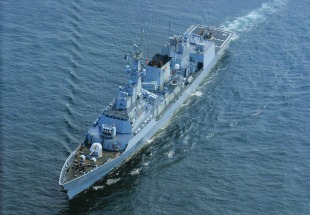



 Pakistan Navy
Pakistan Navy Hudong-Zhonghua Shipbuilding
Hudong-Zhonghua Shipbuilding